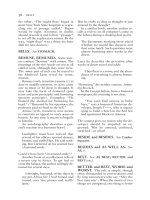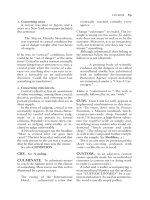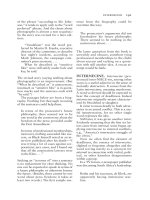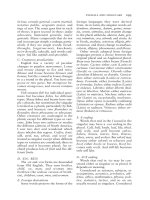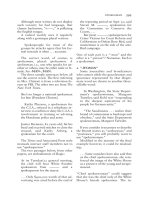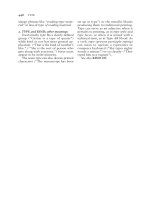3 3 3 american indian lives and traditions
Bạn đang xem bản rút gọn của tài liệu. Xem và tải ngay bản đầy đủ của tài liệu tại đây (2.94 MB, 10 trang )
Fascinating Facts
• American Indians did not become United
States citizens until 1924.
• There were once hundreds of groups of
California Indians in California who spoke
more than one hundred languages.
• The word Indian, the name for the people
who lived in the Americas, came from a
mistake. In 1492 Christopher Columbus
thought he had reached the East Indies,
so he named the people “Indians.”
American Indian
Lives and Traditions
by maureen blaney flietner
Genre
Nonfiction
Text Features
• Glossary
• Captions
• Headings
Scott Foresman Social Studies
ISBN 0-328-17499-8
ì<(sk$m)=bhej h< +^-Ä-U-Ä-U
In this book you will begin to learn about
the first people of California. Though they
are called California Indians, they are
actually many different groups of people.
Each group has its own name. All have a
special connection with the land and with
their past. Today they work to keep their
cultures alive and hope for a better future.
Vocabulary
custom
reservation
tradition
government
ceremony
laws
climate
constitution
adapt
cooperate
weather
economy
folklore
interact
American Indian
Write to It!
Lives and Traditions
While many things have changed for
American Indians, many things have also
by maureen
flietner
remained
the same. blaney
Write one
paragraph
about the things that you think have
not changed.
Write your paragraph on a separate sheet
of paper.
Photographs
Every effort has been made to secure permission and provide appropriate credit for photographic material. The publisher deeply
regrets any omission and pledges to correct errors called to its attention in subsequent editions.
Unless otherwise acknowledged, all photographs are the property of Scott Foresman, a division of Pearson Education.
Photo locators denoted as follows: Top (T), Center (C), Bottom (B), Left (L), Right (R), Background (Bkgd)
ISBN: 0-328-17499-8
Copyright © Pearson Education, Inc. All Rights Reserved. Printed in the United States of
America. This publication is protected by Copyright, and permission should be obtained
from the publisher prior to any prohibited reproduction, storage in a retrieval system, or
transmission in any form by any means, electronic, mechanical, photocopying, recording, or
likewise. For information regarding permission(s), write to: Permissions Department, Scott
Foresman, 1900 East Lake Avenue, Glenview, Illinois 60025.
1 2 3 4 5 6 7 8 9 10 V0G1 14 13 12 11 10 09 08 07 06 05
Opener: (T) ©Galen Rowell/Corbis, (B) ©Richard A. Cooke/Corbis
Editorial Offices: Glenview, Illinois • Parsippany, New Jersey • New York, New York
2 ©Trevor Wood/Getty Images
3 ©Owen Franken/CorbisSales Offices: Needham, Massachusetts • Duluth, Georgia • Glenview, Illinois
5 ©Yva Momatiuk and John Eastcott/Woodfin Camp & Associates
Coppell, Texas • Sacramento, California • Mesa, Arizona
7 ©Eastcott-Momatiuk/The Image Works, Inc.
9 ©Richard A. Cooke/Corbis
10 ©Michael S. Lewis/Corbis
13 ©Alex Wong/Getty Images
14 ©George H. H. Huey/Corbis
15 ©A. Ramey/PhotoEdit
The First People
There is a group of people who have a very special
history with the state of California. They were the
very first people to live here. Who are these people?
They are often called California Indians.
Actually, the California Indians have many names
because they are from many different groups. Each
group has its own name and its own language. Each
has its own customs, or way of doing things. Each
has its own traditions and ceremonies for special
events.
Many California Indians still live in what we now
call California.
American Indians are United States citizens.
California has more American Indians than any
other state. Most Indians in California are from
groups that originally lived here. Others are from
groups across the country who have moved here.
American Indians are United States citizens.
Many have served in the United States military. To
learn about today’s American Indians, we need to
start by looking at their past.
2
3
Understanding and Respect
Long ago, American Indians had a keen
understanding of the areas in which they lived.
Each group studied the climate of its area and
learned to adapt to the weather. The group members
learned how to wisely use the plants, the animals,
the earth, and the water.
Even though each group had its own traditions,
they honored and respected all living things. The
American Indians showed respect by only using
what they needed to survive. They did not waste the
animals or plants.
American Indians taught what they learned or
believed to others in the group through folklore.
They passed on lessons through songs, dances,
customs, and pictures. Children learned as they
grew up in the group. It was like being part of a large
extended family.
The Mojave still live in the desert areas near
where their people once lived. They celebrate their
past through the singing of songs.
4
Storytelling is an important part of American Indian culture.
5
Broken Promises
Forgotten Languages
When European settlers came to American
Indian lands, life changed for American Indians.
By exploring those changes, you may begin to gain
an understanding of today’s American Indians. For
many years, they were not always treated fairly.
Promises to give them land and help were not kept.
American Indians were forced to move many times
to other lands or cities.
Many American Indians were killed in battles
protecting their land. The people who survived
were sometimes not allowed to speak their own
languages. They could not sing their songs or tell
their stories. Many American Indians had to live
among people they did not know. Many started to
forget what it was like to be part of their groups.
Some California groups used to have thousands
of members. Groups today might only have as
many as three hundred members. There are groups
that have no one left. Some American Indians
today might belong to more than one group. Their
parents or grandparents or great-grandparents
may have married someone from another group.
Others married people who were not members of
an American Indian group.
Some groups no longer have anyone who knows
how to speak the tribe’s language. For example,
the Wiyots speak only English today. The last person
who knew how to speak the Wiyot language died in
1962. Some younger members, however, are trying
to learn this language by listening to recordings of
people from years ago.
Many American Indian tribe
members work to learn their
group’s language.
6
Today’s American Indians
Today, American Indians are teachers, scientists,
artists, and businesspeople. Richard Stephens is
a member of the Pala Band of Mission Indians,
who used to live in a region extending from the
California coast to the mountains. In 2004 he
earned an honor from an American Indian group
for being a very good businessperson.
Naomi Lang is an ice dancer. She was born in
California and is a member of the Karuk. She is the
first American Indian woman to have competed in
Winter Olympic Games. She and her partner have
been United States champions in ice dancing many
times.
Many American Indians live in large
cities such as Los Angeles.
8
Today American Indians live in large cities.
Some live in small towns, or areas between small
towns and cities. Other American Indians live on
a reservation that may be home to one or more
groups. These reservations were set up by the
United States government. Small reservations are
called rancherias.
San Diego County has more reservations than any
other county in the United States. Only a small
number of the American Indians who live in that
county live on these reservations.
Some groups earn money through businesses ventures.
Today, the United States government allows
some groups to run their own reservations. For
the most part, each group can have its own tribal
government, make its own laws, and set up its
own constitution. Each group can decide who can
belong and who can vote. Before 1934 the groups
did not have written constitutions or laws.
Each group now can run businesses on its
reservation. Let’s look at some tribes and what they
are doing.
The Bishop Paiute (PEYE-yoot) Reservation runs a
successful tourist business. It has a doctor’s office,
a museum, and educational programs.
10
Fort Mojave Indians run a business. They also
make money by letting an energy company have its
power plant on their land.
The Washoe live in the mountains and valleys near
Lake Tahoe as their people once did. They practice
forest management and have cattle on their land.
Although much history is lost, the Washoe still
remember many ceremonies and traditions. For
example, newborn babies still get a traditional
Washoe blessing. They also teach younger members
about the land, the plants, animals and the water—
just as members of their group did in the past.
Today many California groups cooperate to
improve the economy of all American Indians. They
interact with federal, state, and local governments to
protect their special places. Tribes work together to
save their ways of life, art, folklore, and customs.
11
The National Museum of the American
Indian in Washington, D.C., showcases
American Indian culture.
There Is Much to Learn
In 2004 the National Museum of the American
Indian opened in Washington, D.C. It shows and
tells visitors about the many different American
Indian groups.
Many California Indian artists have had their
work featured. One artist was Kimberly Stevenot
of the Sierra Miwok, many of whom still live in
the Sierra Nevada foothills. Kimberly, who lives in
the city, makes baskets using berries, shells, and
pine nuts just as the Miwok did long ago. Baskets
made by members of her family can be seen at the
Phoebe Hearst Museum in Berkeley, California.
12
One exhibit at the new museum called “Our
Universes,” looks at what eight American Indian
groups think about the Earth and why they honor
all living things. One group chosen to be part of the
exhibit is the Hupa.
Another museum display called “Our Lives” shows
how eight groups of American Indians live in today’s
world. A California group is included in this exhibit.
It is the Campo Band of Kumeyaay Indians who
once lived from the coast to the mountains near
San Diego, California. Through the stories in the
exhibit, people learn how each tribe tries to keep its
traditions alive today.
13
Reaching Our Goals
Many American Indian groups knew how to care for
plants and animals.
American Indian groups of long ago were careful
about how they used the plants and animals of
their area. They were able to keep California’s
plants and animals around for years and years.
Today’s scientists want to learn what many groups
already know. Scientists want to be better able to
conserve natural resources. Scientists are talking to
American Indian elders to see what they remember.
The tribes of long ago used to help plants grow
better by burning some areas. The American Indians
use to break off parts of plants and bury them. They
used to help spread the seeds of plants.
The groups now work with the federal and state
governments in helping to restore plants, animals,
and water.
14
Today American Indians cooperate in many ways.
For example, basketmakers of many groups work
together to help all people learn about American
Indian art. American Indians work to protect land
that has been special to them for hundreds of years.
They work for new laws to protect their traditions.
American Indians interact with others so that
everyone can learn about their culture. Because
many live in cities, many different groups might
plan a ceremony for everyone to enjoy. Sometimes
American Indians visit a reservation to join in a
powwow, or gathering. At a powwow, everyone can
enjoy dances, songs, stories, music, art, and food.
The Cabazon Band of Mission Indians has had an
annual powwow like that for many years.
Today American Indians do not live the way
they did long ago. Their children, however, can
once again learn about their culture’s folklore and
traditions.
In this book you will begin to learn about
Glossary
thetofirst
people
of new
California.
Though they
adapt
change
to fit
conditions
are called California Indians, they are
ceremony
important
activity
done
for a
actuallyanmany
different
groups
of people.
special
Eachreason
group has its own name. All have a
climate
theconnection
weather anwith
area the
usually
special
landhas
andyear
with
after
year
their
past. Today they work to keep their
cultures alive
and hope
future.
constitution
a written
plan for
for aa better
government
cooperate to work together
Vocabulary
custom a way of doing
things
economy how
the resources of
a country, region,
custom
reservation
state or local area are managed
tradition
government
folklore the stories and customs of a group
ceremony
laws
of people
climate
constitution
government the people who run a country or the
adapt
cooperate
laws of a country
interact to weather
talk to other peopleeconomy
and work
with themfolklore
Write to It!
While many things have changed for
American Indians, many things have also
remained the same. Write one paragraph
about the things that you think have
not changed.
Write your paragraph on a separate sheet
of paper.
interact
laws rules made by the government
reservation an area of land set aside by the United
States government for American Indians
tradition a special way a group of people does
something and passes on to others
ISBN: 0-328-17499-8
weather the temperature and conditions of the
air outside at a certain place and time
Copyright © Pearson Education, Inc. All Rights Reserved. Printed in the United States of
America. This publication is protected by Copyright, and permission should be obtained
from the publisher prior to any prohibited reproduction, storage in a retrieval system, or
transmission in any form by any means, electronic, mechanical, photocopying, recording, or
likewise. For information regarding permission(s), write to: Permissions Department, Scott
Foresman, 1900 East Lake Avenue, Glenview, Illinois 60025.
16
1 2 3 4 5 6 7 8 9 10 V0G1 14 13 12 11 10 09 08 07 06 05
Photographs
Every effort has been made to secure permission and provide appropriate credit for photographic material. The publisher deeply
regrets any omission and pledges to correct errors called to its attention in subsequent editions.
Unless otherwise acknowledged, all photographs are the property of Scott Foresman, a division of Pearson Education.
Photo locators denoted as follows: Top (T), Center (C), Bottom (B), Left (L), Right (R), Background (Bkgd)
Opener: (T) ©Galen Rowell/Corbis, (B) ©Richard A. Cooke/Corbis
2 ©Trevor Wood/Getty Images
3 ©Owen Franken/Corbis
5 ©Yva Momatiuk and John Eastcott/Woodfin Camp & Associates
7 ©Eastcott-Momatiuk/The Image Works, Inc.
9 ©Richard A. Cooke/Corbis
10 ©Michael S. Lewis/Corbis
13 ©Alex Wong/Getty Images
14 ©George H. H. Huey/Corbis
15 ©A. Ramey/PhotoEdit
